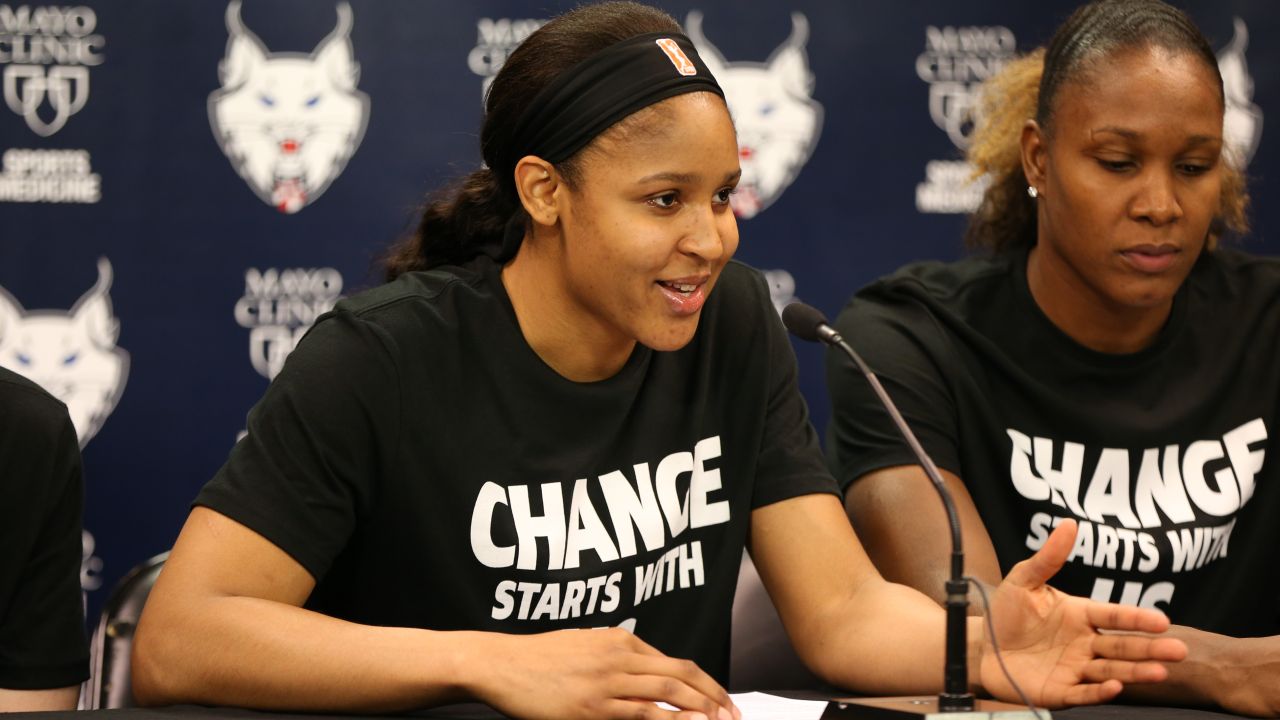
Maya Moore (#23) and Rebekkah Brunson (#32) of the Minnesota Lynx attend a press conference before the game against the Dallas Wings on July 9, 2016 at Target Center in Minneapolis, Minnesota. (Photo by David Sherman/NBAE via Getty Images Copyright 2016 NBAE)
Let’s start with how not to have a conversation about race: Here’s the July 11 Minneapolis Star Tribune:
“Minneapolis cops working Lynx game walk out over player comments, warm-up jerseys. Police union leader says walkout is justified.“
The Lynx are Minnesota’s high-flying WNBA basketball team. An accompanying photo shows two players wearing black T-shirts bearing the words, “CHANGE STARTS WITH US. JUSTICE & ACCOUNTABILITY.” According to the caption, the Lynx players “observed a moment of silence in honor of Philando Castile” — the black man shot to death July 7 when a police officer in a St. Paul suburb stopped him for a broken taillight.
The report begins in the just-the-facts manner that American journalists are taught:
“Four off-duty Minneapolis police officers working the Minnesota Lynx game at Target Center on Saturday night walked off the job after the players held a news conference denouncing racial profiling, then wore Black Lives Matter pregame warm-up jerseys.”
So far, this is pretty standard stuff: There’s a conflict — the players denounced racial profiling, and wore Black Lives Matter jerseys, and the cops walked. This is what you’d expect, because, after all, “everybody knows” that cops and activists are antagonists.
The journalist writes the story “straight down the middle.” If “he” said one thing, “she” said another. So this article takes the easy way. It starts out by offering facts that bear out a popular prejudice. The news report consists largely of one “gotcha” versus another.
Let’s stipulate that these facts are true. (I have no independent information and no reason to doubt them.) The article, by Randy Furst, goes on:
“Lt. Bob Kroll, president of the Minneapolis Police Federation, the union that represents rank-and-file officers, praised them for quitting. ‘I commend them for it,’ he said.”
This sort of he-said, she-said goes on to write itself. The journalistic devices are conventional and time-honored. Conflicts are interesting. Yes-it-is versus no-it-isn’t, black versus white, up versus down. Direct, in-your-face, black-versus-white confrontations are the most accessible, easily packaged conflicts of all. It is this sort of article that drove Norwegian media scholars Johan Galtung and Mari Holmboe Ruge to write, more than 50 years ago, that “’news’ are actually ‘olds’, because they correspond to what one expects to happen.”
For several paragraphs Furst’s article proceeds to skate steadily over the surface, playing back to readers what they already know, or think they know.
Then comes the ninth paragraph, which reads, in its entirety: “Players also denounced the ‘senseless ambush’ of Dallas police.”
Oh? All the players? Some players? The players’ spokeswomen? What else did the Lynx players say, if anything, about the ambush in Dallas?
Far more informative was an earlier Star Tribune piece by Jim Paulsen, filed on July 9, which noted the names of the Lynx spokeswomen, captains Seimone Augustus, Rebekkah Brunson, Maya Moore and Lindsay Whalen, and quoted Brunson as follows:
“Racial profiling is a problem. Senseless violence is a problem. The divide is way too big between our communities and those who have vowed to protect and serve us… Racism and unjust phobic fear and disregard of black females is very real… We do not, in any way, condone violence against the men and women who serve on our police force. Senseless violence and retaliation will not bring us peace…”
Paulsen added that the co-captains didn’t take questions.
Meanwhile, a follow-up piece in The Washington Post July 12 noted (the italics are mine):
“The backs of the shirts bore the names of two men killed by police officers in incidents in Minnesota and Louisiana last week, the logo for the Dallas Police Department and the words, ‘Black Lives Matter.’”
The Post piece, by Des Bieler, also noted that Augustus “is a native of Baton Rouge, La., where one of the men, Alton Sterling, was shot and killed….In 2012, Augustus spoke out about a personal experience of racial profiling by Minnesota police, when she was pulled over for an object hanging from her rear-view mirror that turned out to be an air freshener and was questioned about her out-of-state license plate.”
So — did the off-duty officers who walked out know that the players had “denounced the ‘senseless ambush’ of Dallas police”? Did they see the Dallas logo on the back of the shirts? Did they know about the prior incident involving Augustus? Was Lt. Kroll asked about these facts? Were the off-duty officers who walked out?
And how did the rival team, the Dallas Wings, react? After all, they play for Dallas. It would have been especially interesting to see what they thought about all the killings — five of them in their hometown and one in neighboring Louisiana. Were the Wings irritated, inspired or something else by the fact that their opponents were exercising their right to express themselves? We don’t know.
Nor do we know what the fans — any of them — thought, although we do know there were 7,613 of them in attendance. Since assumptions are flying around thick and fast about racial polarization in America, wouldn’t it have been interesting to read what some citizens think?
The Star Tribune’s July 11 article is not only shallow, it also traffics in stereotypes and stereotypes only. It doesn’t seek out information that might complicate the idea of polarization.
This is the journalism of resignation. It shrugs its shoulders. It says, in effect, polarization is everywhere and absolute. It says that the truth here is signed, sealed, and delivered. If there is any contrary evidence to be gathered, the reader won’t know.
A “conversation about race” is not accomplished by acts of stenography, tit versus tat, black hats versus white hats. A conversation jostles assumptions. A conversation seeks to grasp and explore more than two points of view. It investigates why people say what they say, and whether any of them change their minds because they might have heard — if they were listening — something other than what they expected to hear.
Journalists can expedite that conversation, or they can spin their wheels and contribute to the vast blindness afflicting an agonized nation that, at least sometimes, strives to learn something it doesn’t already know.




